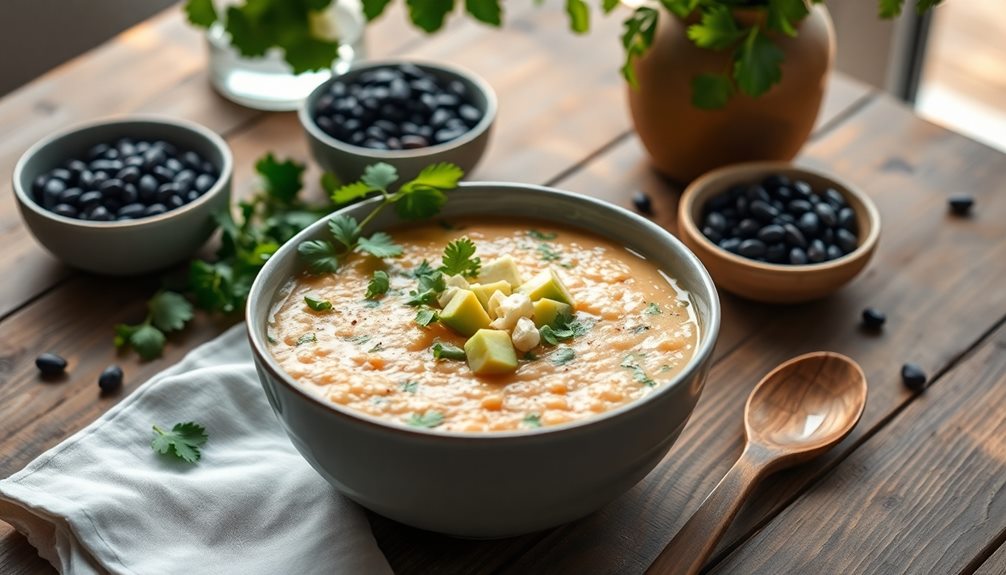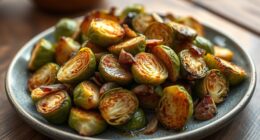The second rise is essential when making Nigerian puff-puff because it allows the dough to ferment fully and produce enough gas, making your treats light, fluffy, and airy. During this stage, the dough expands further, and gluten relaxes for a tender texture. Skipping this step can make your puff-puff dense and less soft. If you want perfect, golden puff-puff, understanding how to get this second rise just right will make a big difference.
Key Takeaways
- The second rise allows the dough to expand further, making puff-puff fluffy and light.
- It ensures even yeast distribution, leading to uniform texture and better fermentation.
- Patience during the second rise develops flavor and enhances the puff-puff’s taste.
- It relaxes gluten, resulting in softer, more tender puff-puffs.
- Skipping the second rise results in denser, less airy puff-puffs with reduced fluffiness.

Have you ever wondered why Nigerian puff-puffs turn out perfectly fluffy and golden every time? The secret lies in understanding the *crucial* step of the second rise. When you make puff-puff dough, yeast activation plays a *vital* role. Yeast, a living organism, needs to be properly activated to produce the necessary carbon dioxide that makes your dough rise. To achieve this, you typically warm a bit of milk or water and mix in yeast along with a touch of sugar. Once the yeast starts bubbling and foaming—usually after about five minutes—you know it’s active and ready for the next step. This process, called dough fermentation, is where yeast works its magic, converting sugars into carbon dioxide and alcohol. This fermentation process is what creates the lightness and fluffiness that characterize authentic Nigerian puff-puffs. Proper fermentation relies on the temperature of your environment, as warmer conditions accelerate fermentation, while cooler ones slow it down. Additionally, ensuring the yeast is fresh and properly activated is essential for consistent results. Yeast activity is also influenced by factors like moisture content, which should be optimal for fermentation to proceed smoothly. Maintaining the right fermentation environment is crucial because it affects the yeast’s ability to produce gases efficiently and develop that desirable texture.
However, just mixing the ingredients and letting the dough sit once isn’t enough. The dough needs a second rise to develop that soft, airy texture. After your initial mixing, you should knead or stir the dough thoroughly to *guarantee* even distribution of yeast and other ingredients. Then, cover the bowl with a damp cloth or plastic wrap, and let it sit in a warm, draft-free spot. During this second fermentation, the yeast continues to produce gases, causing the dough to expand further. This extra rise allows the gluten structure in the dough to relax and develop, which results in puff-puffs that are not only fluffy but also tender and light inside. Ensuring a proper fermentation environment is essential for achieving the perfect texture in your puff-puffs. Remember, patience during this stage helps develop the flavor and texture that make puff-puffs truly delicious.
Skipping the second rise can lead to denser puff-puffs that don’t quite have that soft, airy interior you’re aiming for. It’s tempting to rush through the process, but patience pays off here. When you allow the dough to ferment again, you give the yeast more time to work, creating more carbon dioxide and *assuring* the dough is thoroughly aerated. This is what gives your puff-puffs that iconic golden exterior and fluffy inside. Remember, the *temperature* of your environment matters too—warmer conditions accelerate fermentation, while cooler ones slow it down. Properly managing this environment can make the difference between a good puff-puff and a great one.
Frequently Asked Questions
Can Puff‑Puff Be Fried Immediately After Mixing?
You can fry puff‑puff immediately after mixing, but letting the batter ferment first offers benefits. Fermentation enhances flavor, improves dough elasticity, and creates a softer, fluffier texture. Skipping this step might result in denser, less airy puff‑puff. For the best results, allow the batter to ferment for a while, which helps develop the flavors and ensures your puff‑puff is light, tender, and perfectly puffed up.
How Does the Second Rise Affect Puff‑Puff Texture?
Imagine your puff‑puff as a gentle wave ready to crest. The second rise enhances dough elasticity, giving it more structure and allowing trapped air to expand during frying. This fermentation benefits the dough by producing lighter, fluffier puff‑puff with a tender crumb. Without this step, the texture might be denser and less airy, losing that signature soft and fluffy quality you crave.
What Are the Signs of Over-Proofed Puff‑Puff Dough?
When you notice signs of over-proofed puff‑puff dough, fermentation indicators become evident, such as overly sour smell and excessive bubbling. The dough’s elasticity will diminish, making it overly soft and difficult to shape. You might also see deflation or a flat appearance after frying. These signs mean the dough has fermented too long, losing its structure, which can affect the final texture, making your puff‑puff dense and less fluffy.
Is a Second Rise Necessary for All Nigerian Snacks?
You might wonder if a second rise is necessary for all Nigerian snacks. Not always—some recipes benefit from fermentation benefits, which improve dough elasticity and flavor, making a second rise useful. For puff‑puff, it helps develop texture and lightness, but other snacks may not need it. Consider the specific recipe and desired outcome to decide if a second rise enhances your snack’s quality.
How Long Should the Second Rise Last for Optimal Results?
Ever wondered how perfect puff-puff becomes irresistibly fluffy? You should allow a proofing duration of about 30 to 45 minutes for the second rise, as it enhances fermentation, creating a lighter, airy texture. During this fermentation process, the dough develops flavor and volume. Keep an eye on it—if it doubles in size, you’re ready to fry. Proper proofing guarantees your puff-puff is soft, delicious, and well-risen.
Conclusion
So, next time you make puff-puff, don’t skip the second rise. It’s the secret to achieving a cloud-like, irresistibly fluffy treat that could rival the softest clouds in the sky. Skimp on this step, and you risk turning your beloved snack into a flat, unremarkable disappointment. Embrace the second rise, and watch your puff-puff transform into a divine masterpiece—trust me, it’s worth every moment to elevate your baking game to legendary status.










